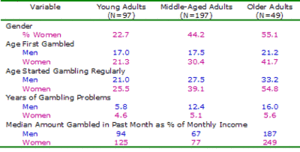The WAGER Vol. 7(25) – Gambling at Any Age
Gambling participation among the oldest segment of the American population has grown dramatically. Between 1975 and 1999, the number of individuals over 65 reporting gambling in their lifetimes swelled from 35% to 80% (Kallick et al.,1976; NORC,1999). However, research pertaining to pathological gambling among the elderly is just beginning to emerge. This week the WAGER summarizes a recent study by Nancy Petry that focuses on the gambling experiences and psychosocial problems of older adult pathological gamblers (Petry, 2002).
Between August 1998 and July 2000, Petry recruited 343 consecutively admitted individuals entering two Connecticut gambling treatment programs. Participants completed the Addiction Severity Index (ASI; McLellan et al., 1985) at intake to the treatment program. The ASI assesses the severity of various psychosocial problems experienced within the last month and includes a section specifically assessing gambling activity (Lesieur & Blume, 1991). The ASI uses a scale from 0.00 to 1.00 to measure severity, with one being the most severe. Participants also completed the South Oaks Gambling Screen (Lesieur & Blume, 1987); all participants’ scores exceeded 5 affirmative responses, the conventional cutoff associated with probable pathological gambling. For analysis, Petry divided participants into three age groups: young adults (18 to 35 years), middle age (36 to 55 years) and older adults (56 years and older). Table 1 presents the significant differences (p<.05) among gambling variables across these age groups.
Table 1. Significant Age & Gender Group Differences in Selected Demographic and Gambling Variables
This study found that age and gender have important effects on individuals’ gambling histories. Men and women did not always show the same age effects. For example, whereas men in all age groups began gambling when they were young, the average age that women started gambling regularly varied with age group. The oldest group of women began gambling much later in life (mean age 42 years) than the younger women (22 years). Similarly, although the age at which patients began to gamble regularly increased with age for both genders, the increase was far more dramatic in women. Regardless of the age when they started gambling regularly, women endured about five total years of gambling problems before entering the current treatment program. The youngest group of men had a similar term for their gambling problems but the number of years increased as age increased. In the oldest age group, the average number of years with gambling problems was three times longer for males than females. Finally, as men and women got older, they both increased the proportion of income that they gambled. This effect was more pronounced in women. Women in the oldest age group wagered 249% of their monthly income (1).
This study is limited in its ability to generalize to the larger population of pathological gamblers. Participants were treatment-seekers and might differ in important ways from gamblers who do not enter treatment programs. In addition, the study broadly defines older adults as those over 55 years. Retirement is related to lifestyle changes; defining the oldest group as 55 and up dilutes the impact of retirement on gambling behaviors. Unfortunately, in this study the low numbers of older adults seeking treatment precludes the analysis of retirees separately.
As one of the first studies to explore pathological gambling in older adults, this study offers important insights into an aging population. Patients of different age groups varied substantially in demographic
and psychosocial characteristics, with disparity between men and women across age groups. Clinicians can use this information to tailor interventions and treatment. For example, interventions directed to older people should recognize that this is a time when women are beginning to gamble regularly while men are more often lifetime gamblers who might have been battling gambling problems for years longer than their female counterparts.
Comments on this article can be addressed to Rachel Kidman.
Notes
1. The money wagered in excess of 100% of the individual monthly income may come from household income, savings accounts, borrowing, or obtaining money from any number of other sources.
References
Kallick, M., Suits, D., Dielman, T., & Hybels, J. (1976). A survey of American gambling attitudes and behaviors. Washington, D.C.: Government Printing Office.
Lesieur, H. R., & Blume, S., B. (1991). Evaluation of patients treated for pathological gambling in a combined alcohol, substance abuse and pathological gambling treatment unit using the Addiction Severity Index. British Journal of Addiction, 86, 1017-1028.
Lesieur, H. R., & Blume, S. B. (1987). The South Oaks gambling screen (SOGS): A new instrument for the identification of pathological gamblers. American Journal of Psychiatry, 144(9), 1184-1188.
McLellan, A. T., Luborsky, L., Cacciola, J. S., & Griffith, J. (1985). New data from the Addiction Severity Index: Reliability and validity in three centers. Journal of Nervous and Mental Disorders, 173, 412-423.
National Opinion Research Center. (1999). Gambling impact and behavior study. Chicago: University of Chicago.
Petry, N. M. (2002). A comparison of young, middle-aged, and older adult treatment-seeking pathological gamblers. The Gerontologist, 42(1), 92-99.
